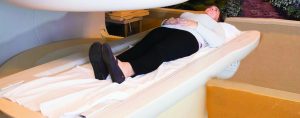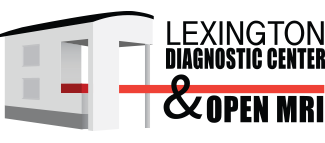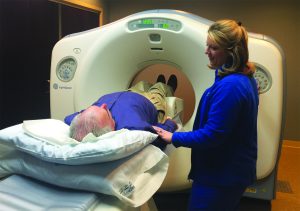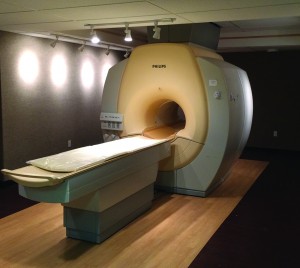Take a look inside: Magnetic Resonance Imaging
 Magnetic Resonance Imaging ? MRI ? is one of the most important developments in the field of medicine in the past 30 years. MRIs have become a virtual workhorse, allowing physicians to locate tumors and cysts, evaluate joint damage, pinpoint the cause of back pain, and diagnose a wide variety of conditions.
Magnetic Resonance Imaging ? MRI ? is one of the most important developments in the field of medicine in the past 30 years. MRIs have become a virtual workhorse, allowing physicians to locate tumors and cysts, evaluate joint damage, pinpoint the cause of back pain, and diagnose a wide variety of conditions.
MRI technology has saved patients millions of dollars in healthcare expense; shortened time to diagnosis (and thus, treatment); allowed patients to avoid exposure to radiation; and improved the quality and length of lives of people across the U.S.
How does MRI differ from other types of medical imaging?
First, MRI studies are performed using magnetic fields. This is unique in the diagnostic imaging world, where most studies (with the exception of ultrasound) use ionizing radiation to create images of the body. There is no radiation exposure during an MRI. Instead, the equipment uses a very strong magnetic field to align the spin of hydrogen protons in the cells of the body and radio waves to cause the protons to wobble. As they wobble, the emit radio waves, which are detected by sensors in the machine.
Tissues that contain more water, such as muscles or the brain, emit stronger radio signals. Tissues that contain less water, such as bones, emit weaker signals. As it turns out, this is a perfect alignment of capabilities: X-rays are great at imaging dense tissues, such as bone, and poor at imaging soft tissues, such as muscles and brain.
You’ll sometimes hear MRI machines referred to as 3T or 1.5T. These terms refer to the strength of the magnet in relationship to the magnetic field of the earth. The larger the number, the stronger the magnetic field. (The T, by the way, honors Nikola Tesla, an electrical engineer and rival of Thomas Edison. He’s best known for his advocacy of and contributions to the development of the modern alternating current (AC) electrical system).
At Lexington Diagnostic Center and Open MRI, we have three MRI units: Our 0.6T open MRI is great for people with varying body types and those who have claustrophobia. The unit provides quality images and is open on three sides, making it possible for people who might not otherwise be able to undergo MRI to have this important test.
Our 1.5T high field MRI is open on both ends, provides faster scans, and high-quality images.
The 3T unit also is open on both ends and provides excellent quality, high-
resolution images. It is excellent for orthopedic, neuro and prostate imaging.
One of the great benefits for patients with MRI technology is that family members are usually able to accompany them in the scan room without risk of radiation exposure. Patients are able to listen to their own music (or ours) and are often in and out in less than an hour, with no restrictions on the rest of their day.
Lexington Diagnostic Center and Open MRI has been serving the needs of patients in this area for more than 30 years, providing high-quality imaging studies; compassionate, patient-centered care; great value; and easy access to needed services.
Because medical imaging is all
Lexington Diagnostic Center does, the Center is able to save its patients hundreds of dollars off the price of the same exam performed at a hospital ? These days, when patients are responsible for more and more of their healthcare costs, it really pays to shop around.
In addition, the cost of reading and interpreting the MRI exam (the radiologist fee) is included. Lexington Diagnostic Center patients save significantly, while receiving top-notch care and quality.

 It should come as no surprise that Kentucky leads the nation in lung cancer deaths, especially when you consider another dubious distinction the Commonwealth holds: the highest smoking rates in the nation.
It should come as no surprise that Kentucky leads the nation in lung cancer deaths, especially when you consider another dubious distinction the Commonwealth holds: the highest smoking rates in the nation. Chances are, you or someone you know has needed an MRI scan at some point. We’ve at least all heard of an MRI and might imagine ourselves getting in to that big white tube! But what exactly are we getting ourselves in to? With the help of Paula Bracken, chief radiologic technologist at Lexington Diagnostic Center & Open MRI, let’s explore what you should know, consider, and expect when you need an MRI.
Chances are, you or someone you know has needed an MRI scan at some point. We’ve at least all heard of an MRI and might imagine ourselves getting in to that big white tube! But what exactly are we getting ourselves in to? With the help of Paula Bracken, chief radiologic technologist at Lexington Diagnostic Center & Open MRI, let’s explore what you should know, consider, and expect when you need an MRI.